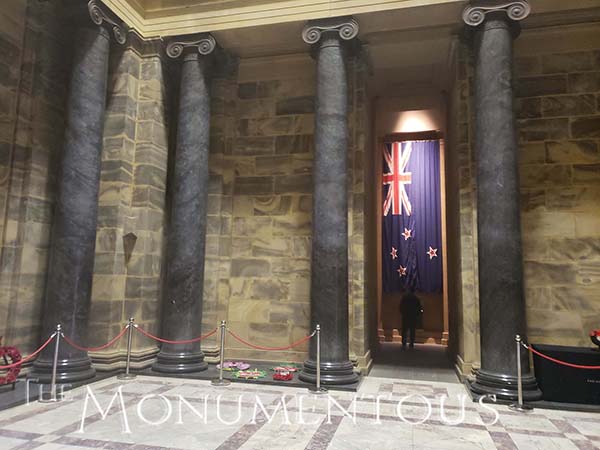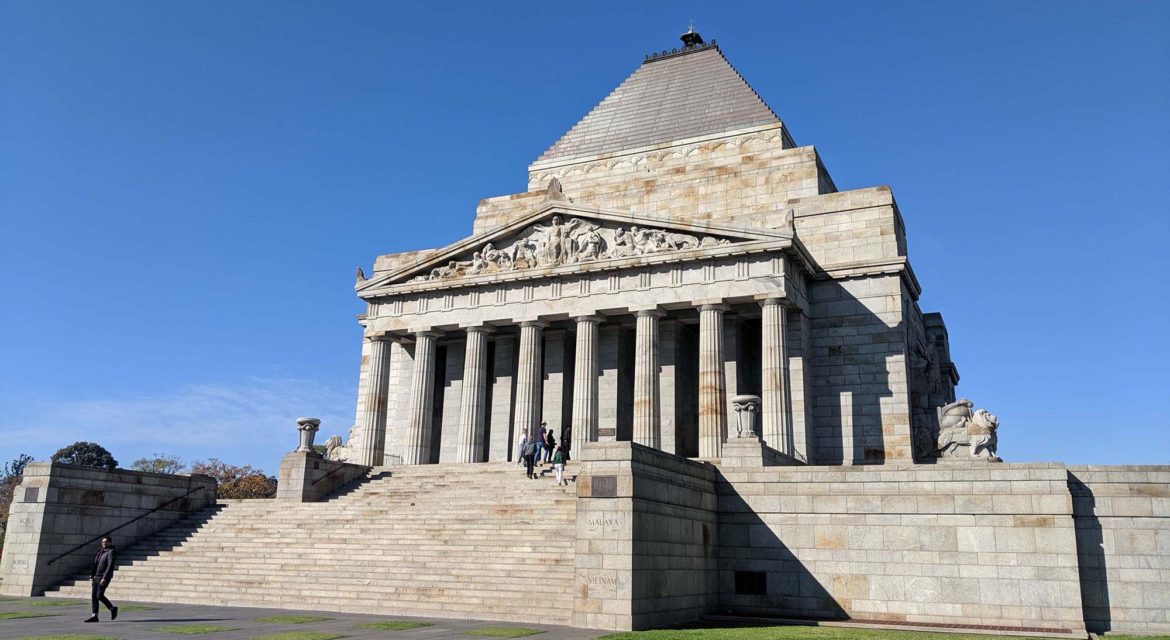 Like other monuments dedicated to veterans of various armed conflicts, the Shrine of Remembrance in Melbourne, Australia honors all those who have served in the armed conflicts and peacekeeping operations in which Australia has participated. As one of the largest war memorials in Australia, the Shrine represents a legacy that is as much about history as it is the culture of the area and nation. That has allowed it to attract audiences from across the world.
Like other monuments dedicated to veterans of various armed conflicts, the Shrine of Remembrance in Melbourne, Australia honors all those who have served in the armed conflicts and peacekeeping operations in which Australia has participated. As one of the largest war memorials in Australia, the Shrine represents a legacy that is as much about history as it is the culture of the area and nation. That has allowed it to attract audiences from across the world.
From World War I to World War II and Beyond
 Dedicated on Remembrance Day in 1934 by the Duke of Gloucester, son of King George V, the Shrine of Remembrance was built to honor the 114,000 men and women of Victoria who served in the Great War of 1914-1918. Of the 89,000 who served overseas, 19,000 did not return home.
Dedicated on Remembrance Day in 1934 by the Duke of Gloucester, son of King George V, the Shrine of Remembrance was built to honor the 114,000 men and women of Victoria who served in the Great War of 1914-1918. Of the 89,000 who served overseas, 19,000 did not return home.
After World War II, many felt it was felt necessary to add an element that could honor the Australians who sacrificed their lives in this conflict. During the Vietnam War, the Shrine became a center of conflict when anti-war demonstrators protested during ANZAC Day services against Australia’s involvement in the war. In 1985 the Remembrance Garden was added beneath the western face of the Shrine to honor those who served during post-World War II conflicts. All of these endeavors saw the Shrine become a monument to much more than a single conflict.
While the Shine itself is the main attraction, there are numerous experiences that visitors can have across the Shine monument and Memorial Gardens that contain everything from a Remembrance Garden to Second Word War Forecourt.

Experiences Inside, Outside and All Around
 The design of the Shrine is based on the ancient Mausoleum at Halicarnassus, one of the Seven Wonders of the World. The granite sculptures on the eastern walls represent Peace & Goodwill and Justice and on the western walls, the statues signify Patriotism and Sacrifice. The carvings over the northern entrance represent The Call to Arms while the ones over the southern entrance denote The Homecoming.
The design of the Shrine is based on the ancient Mausoleum at Halicarnassus, one of the Seven Wonders of the World. The granite sculptures on the eastern walls represent Peace & Goodwill and Justice and on the western walls, the statues signify Patriotism and Sacrifice. The carvings over the northern entrance represent The Call to Arms while the ones over the southern entrance denote The Homecoming.
The names of all Victorians who served in the Great War are in the Books of Remembrance within the forty-two bronze caskets along the walls of the ambulatory within the Shrine. Beneath the Sanctuary is the Crypt containing a bronze statue of a father and son, representing the two generations who served in the two world wars. The Galleries of Remembrance contains interactive displays, 800 unique artifacts, images, films and personal effects. It is a pre-eminent war memorial for the display and interpretation of Australian military history.
The Stone of Remembrance is located in the Sanctuary of the Shrine. At 11 am on the 11th of November of each year, the time at which hostilities ceased in the Great War, a ray of sunlight rests on the word “Love”.
 The Second Word War Forecourt comprises the Eternal Flame, the Cenotaph, the Flagpoles and the Forecourt. It represents a memorial to those men and women who served in the 1939-1945 war. The names of the theaters of war where Australians served are shown on the walls of the Cenotaph. The statuary surmounting the column represents six men carrying a bier on which lies the figure of a dead comrade draped with the national flag. The nearby Eternal Flame has burned continuously since 1954 when it was lit by Queen Elizabeth II at the opening of the forecourt memorial.
The Second Word War Forecourt comprises the Eternal Flame, the Cenotaph, the Flagpoles and the Forecourt. It represents a memorial to those men and women who served in the 1939-1945 war. The names of the theaters of war where Australians served are shown on the walls of the Cenotaph. The statuary surmounting the column represents six men carrying a bier on which lies the figure of a dead comrade draped with the national flag. The nearby Eternal Flame has burned continuously since 1954 when it was lit by Queen Elizabeth II at the opening of the forecourt memorial.
The Remembrance Garden features a pool, waterfall and Harcourt granite wall bearing the names of the conflicts and peacekeeping operations in which Australia participated following World War II, such as Kuwait (Gulf War) and East Timor. The Macroberston Fountain and Cobbers Memorial are located off to the edge of the Memorial Garden, both of which honor distinct legacies associated with World War I.
The Garden, Forecourt and all of the other outside features can be easily seen from the balcony of the Shine, which allows visitors to walk all the way around the structure. The experience from up top enables visitors to get an incredible view of Melbourne, but it’s just a hint at how the Shrine has made an impact on the culture and economy of the city.

Cultural and Economic Impacts of and for Melbourne
 The Permanent Exhibitions showcase everything from the Galleries of Remembrance to Private Memorials, highlighting an important way the Shine celebrates the culture of the nation. Special and Temporary exhibits like “Flowers of War” attract attention from both residents since they provide ever-changing experiences. Ceremonies and wreath laying services are also held throughout the year, further illustrating the ongoing cultural impact of the monument.
The Permanent Exhibitions showcase everything from the Galleries of Remembrance to Private Memorials, highlighting an important way the Shine celebrates the culture of the nation. Special and Temporary exhibits like “Flowers of War” attract attention from both residents since they provide ever-changing experiences. Ceremonies and wreath laying services are also held throughout the year, further illustrating the ongoing cultural impact of the monument.
Shrine Tours allow participants to delve deeper into the history to further explore the monument’s historical and cultural significance. Guides take participants on a 75-minute journey to detail the man stories behind the Shrine. Viewers can get a totally different perspective around areas such as the Sanctuary, Crypt and Galleries. Costs for these tours vary depending on the group size.
In terms of other sources of direct revenue, the Shrine is dedicated to advancing the understanding of the sacrifices made by Australians for their country in times of conflict. One of the ways they’ve done this is by providing spaces for events of a commemorative nature and book launches. Numerous events can be booked at and take place at the Shrine throughout the year.
Additionally, public programs take place throughout the year, while becoming a Friend of the Shine allows people to become part of the Shrine community. The Shire also contains numerous unique items for sale that ranges from coins to shirts the drinkware. Some of these can also be purchased online, while there are numerous ways and places to donate to the Shine, all of which continue to enable and support a legacy that is about so much more than conflict and war.

More than a War Memorial
 The Shrine of Remembrance was supposed to only honor the men and women of Victoria who served in World War I but quickly came to celebrate all of the people who served in any conflict. In doing so, the Shine itself has been able to become more than a war memorial. By enabling such a variety of unique and powerful experiences, the Shine has enabled a legacy that people from across the world can come to celebrate.
The Shrine of Remembrance was supposed to only honor the men and women of Victoria who served in World War I but quickly came to celebrate all of the people who served in any conflict. In doing so, the Shine itself has been able to become more than a war memorial. By enabling such a variety of unique and powerful experiences, the Shine has enabled a legacy that people from across the world can come to celebrate.


